|
-
27th July 19, 10:36 PM
#1
Is this a well-made kilt?
Hello, everyone.
I've just had a kilt made in a personal tartan of 16 oz wool milled by D.C. Dalgliesh. I'm very pleased with the quality of the material, but I have some doubts about the quality of the end product.
First off, this is how the kilt looks:

However, since picking it up yesterday, I have noticed some details that I think are unusual.
Is it normal for the apron to be this loose when the buckles are as tight as they can possibly go?
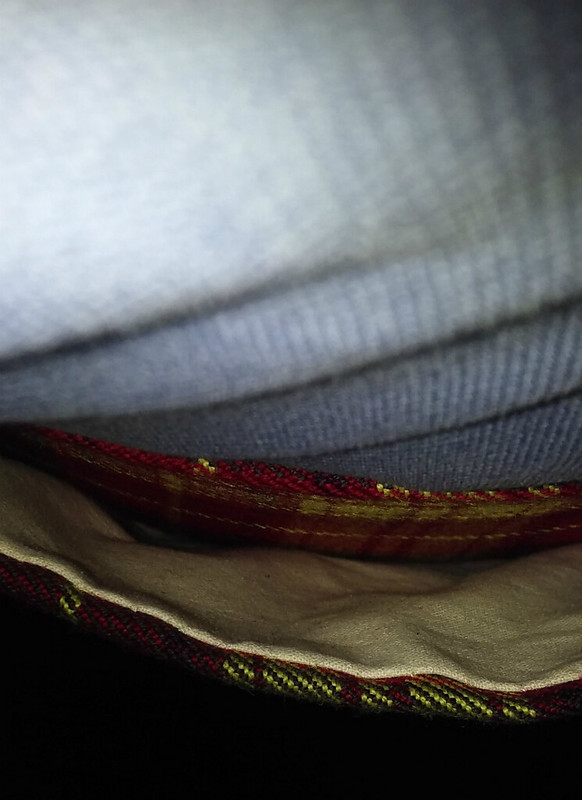
There is also pucker in the apron along the waistband and the bottom edge curls.

It has 27 pleats. The final pleat on each side is very narrow, which the kiltmaker said she put in so that the kilt can be let out if I put on a bit of weight. However, the other 25 pleats vary in width from 5/8" to 7/8" at the fell to 7/16" to 7/8" (yes, at least one pleat has no taper) at the rise. Some elements of the tartan also disappear in the tapering.
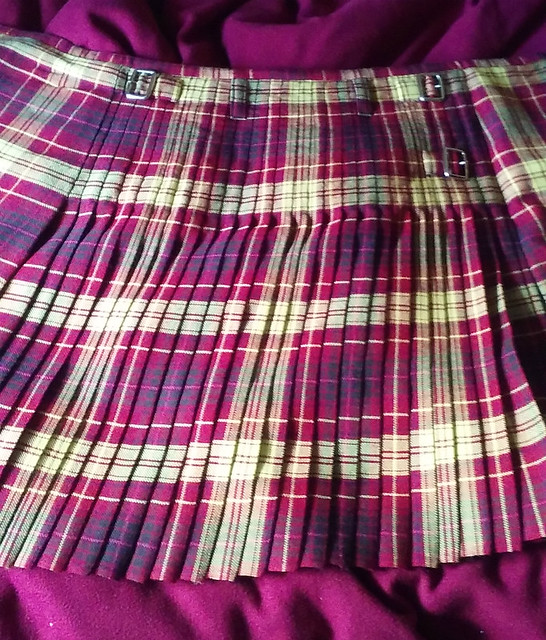
And this may be normal, but the inverted pleat looks massive.

Now this is my first real kilt, but to me it feels very heavy in the back. I had 8 metres of the tartan made and the kiltmaker put all of this material into the kilt. I thought there should have been some left over.
The lady who made it is apparently the only kiltmaker in my city (Perth, Western Australia), and I have only ever heard positive things about her. She has made kilts for some of my uncles. However, she seems to have recently hired someone new to help her. Perhaps this inexperienced person has had a hand in the making of my kilt. Or perhaps I'm being too picky.
Any thoughts? Comments?
-
-
27th July 19, 10:56 PM
#2
I can't help with the kilt question but could you tell us about the bespoke tartan; name etc.?
-
-
27th July 19, 11:59 PM
#3
 Originally Posted by figheadair

I can't help with the kilt question but could you tell us about the bespoke tartan; name etc.?
Hi figheadair. The tartan is registered as Thom, Calum (Personal), designed by me.
-
-
28th July 19, 04:49 AM
#4
I can't give any advice on the construction questions. I think the pattern and colors are wonderful and wanted you to know. I'm sure our kilt makers will join in with suggestions soon.
-
The Following 4 Users say 'Aye' to Tarheel For This Useful Post:
-
29th July 19, 11:27 PM
#5
First off, I would try adjusting the tightness of the straps. Having them all as tight as possible doesn't sound good. It certainly would feel unnatural.
Making sure to have the kilt at your natural waist (about 2" higher than you might wear a pair of p@nts), try to balance the top straps to take the weight of the kilt equally. The lower strap on the right side should be slightly looser than the one at the waist.
I am a bit concerned about what you mentioned regarding the pleating. Hopefully a kiltmaker will be able to interpret this for you.
Nice bit of tartan designing. Have you registered it with the Scottish Register of Tartans? The whole process is costly and time consuming, but I am glad I did so myself.
EPITAPH: Decades from now, no one will know what my bank balance looked like, it won't matter to anyone what kind of car I drove, nor will anyone care what sort of house I lived in. But the world will be a different place, because I did something so mind bafflingly eccentric that my ruins have become a tourist attraction.
-
-
30th July 19, 06:43 AM
#6
IMHO, I would, personally, go back to the kiltmaker, with the kilt, and discuss with them ( for a start).
Normally, the pleats should all be the same size, and elements should not disappear. The size of the inverted pleat shouldn’t make a difference.
waulk softly and carry a big schtick
-
-
30th July 19, 06:49 AM
#7
 Originally Posted by jhockin

IMHO, I would, personally, go back to the kiltmaker, with the kilt, and discuss with them ( for a start).
Normally, the pleats should all be the same size, and elements should not disappear. The size of the inverted pleat shouldn’t make a difference.
Respectfully, no - the pleats shouldn't be all the same size. They will vary as the elements of the tartan are brought into harmony and consistency.
I have concerns about this kilt, but I'll wait to hear from the professional kiltmakers on that score and bow to their opinions.
Rev'd Father Bill White: Retired Parish Priest & Elementary Headmaster. Lover of God, dogs, most people, joy, tradition, humour & clarity. Legion Padre, theologian, teacher, philosopher, linguist, encourager of hearts & souls & a firm believer in dignity, decency, & duty. A proud Canadian Sinclair.
-
-
30th July 19, 07:51 AM
#8
 Originally Posted by Gryphon noir

Nice bit of tartan designing. Have you registered it with the Scottish Register of Tartans? The whole process is costly and time consuming, but I am glad I did so myself.
Jumping in here, the answer is yes, here. We also have it in the STA's Master Db.
-
-
30th July 19, 10:18 AM
#9
Not actually a kiltmaker here, they should chime in before too long.
Now to clarify, the face of the pleats that is actutally showing is different for each, or the total amount of fabric for the entire pleat is different? The latter is logical as your kilt is to the sett.
Second, is the kilt starting to fall off of you, even at the tightest setting of the straps?
Third, did they sew down liner for the entire pleat area or is it loose on the bottom?
Fourth, does it seem they included a piece of stabilizer canvas, and sewed it securely across the entirety of the kilt waist?
-
-
30th July 19, 01:11 PM
#10
OK, many of the other kilt makers may feel a bit reluctant to chime in. So I'll just jump in and I'll try my best to do it politely and without knocking your kilt.
This would not be considered a first quality kilt. But I say that with reservations.
There are many different ways to make a kilt. This is why I don't like to use words like "traditional" when talking about kilt construction. Yes, you may wear a kilt in a traditional manner but over the past couple hundred years there have been thousands of makers and each is trying to find a way for their product to stand apart from all the rest. I have seen far too many different ways to make a kilt for any one to be called "The Traditional Method".
But, with that said, there are a few points I would like to bring out.
If the kilt fabric is folded into knife pleats like your is - and the Tartan pattern is arranged in the pleats to display the entire Sett as yours is - There are a couple of 'normal' conventions that most kilt makers keep to.
The first is that the tartan element that is in the center of the front apron will also be centered in the back.
Second, it is felt that it is more pleasing to the eye if the entire Tartan pattern is repeated in the pleating, from the hip down, just as you would see it in a flat piece of the fabric.
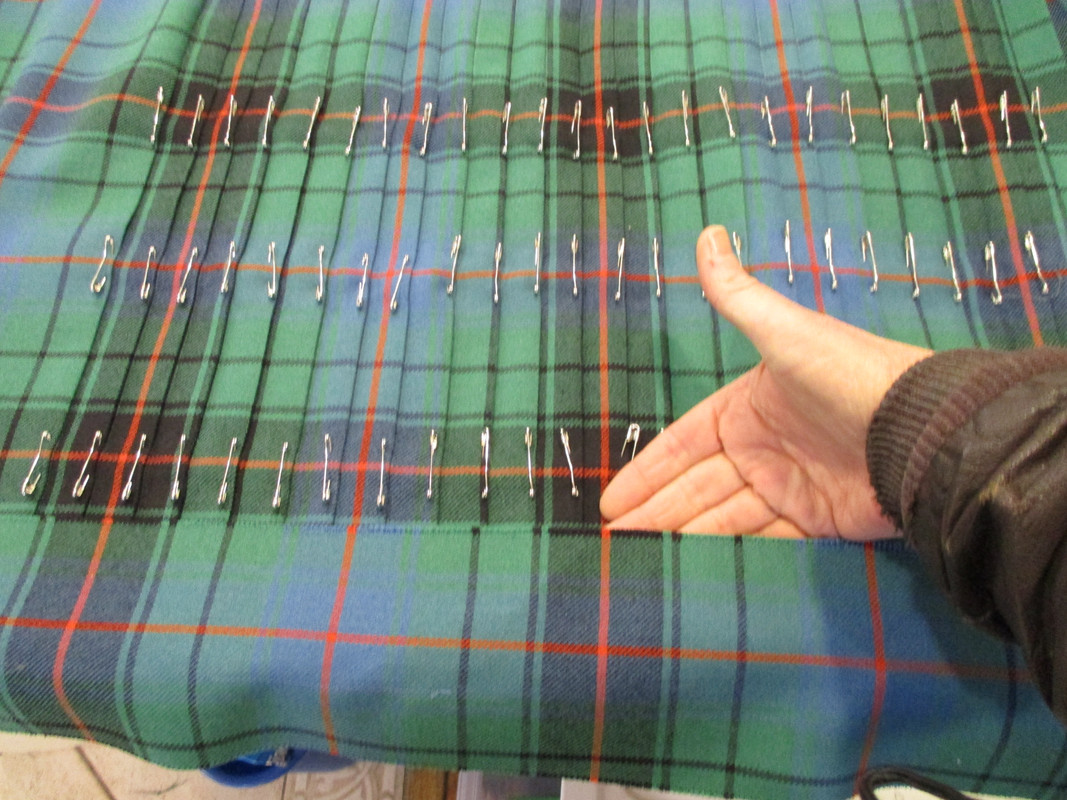
But - And this is a big one - There are a couple of different ways to achieve this look.
One is to vary the width of the pleats to keep the pattern uniform. One pleat may be a slightly different width than the one right next to it. This takes an artists eye and some level of skill and a very good 'feel' to Tartan to achieve successfully. This is the method Barb Tewksbury teaches in "The Art of Kiltmaking".
You can also see cases where one edge of a pleat, when a thin line has to go right down the edge, for that edge to be straight and all the tapering is done with the opposite side.
Another is to keep the width of all the pleats the same but vary the width of all the pleats uniformly to keep the pattern. This is the heart of the "Contemporary" kilt making method, and was used in the photo above.
Most kilt makers try to fold the fabric so that no element of the Tartan is missing AND they also try to plan the pleats so that when the pleats are tapered, that no element just ends creating what we call "Spear Points".
You can see both of these issues in the white sections of your pleating.
This is about how the tapered section of a kilt pleated to Sett will usually look.

Now on to some of your other issues.
The two aprons should be the same "Tightness". I suspect that the maker did not position the buckles and tabs taking into account that the outer apron is on top of the under apron and is therefore of a slightly different circumference. It appears that either the right or left side buckles are too loose or one too loose and the other too tight. These can be moved by any competent tailor, but - only if, when sewn back on, the stitching goes completely through the outer Tartan fabric and is firmly anchored to the interfacing and stabilizer built into the inside of the kilt. These internal elements are then hidden by the inner liner. Many kilts are sewn so that the internal elements are never seen and many kilt owners do not even know that they are supposed to be there in a first rate kilt.
But again, a caution. Your kilt must have these internal elements installed in the first place. The way that you tell is to lay out kilt out on a table and pull on the two buckles across the back. You should see no stretch or give in the back pleated area. None, nada. If you see any stretching, if you see the stitching being stressed, or if the fabric distorts, it is a good bet that the kilt is made more like a casual style kilt and not a first rate kilt.

The lack of internal strengthening elements causes all the stress of strapping the kilt on, and moving in your kilt, to be transferred to the outer Tartan fabric and the stitching. After a while the Tartan fabric will become so distorted that it will no longer return to its original shape.
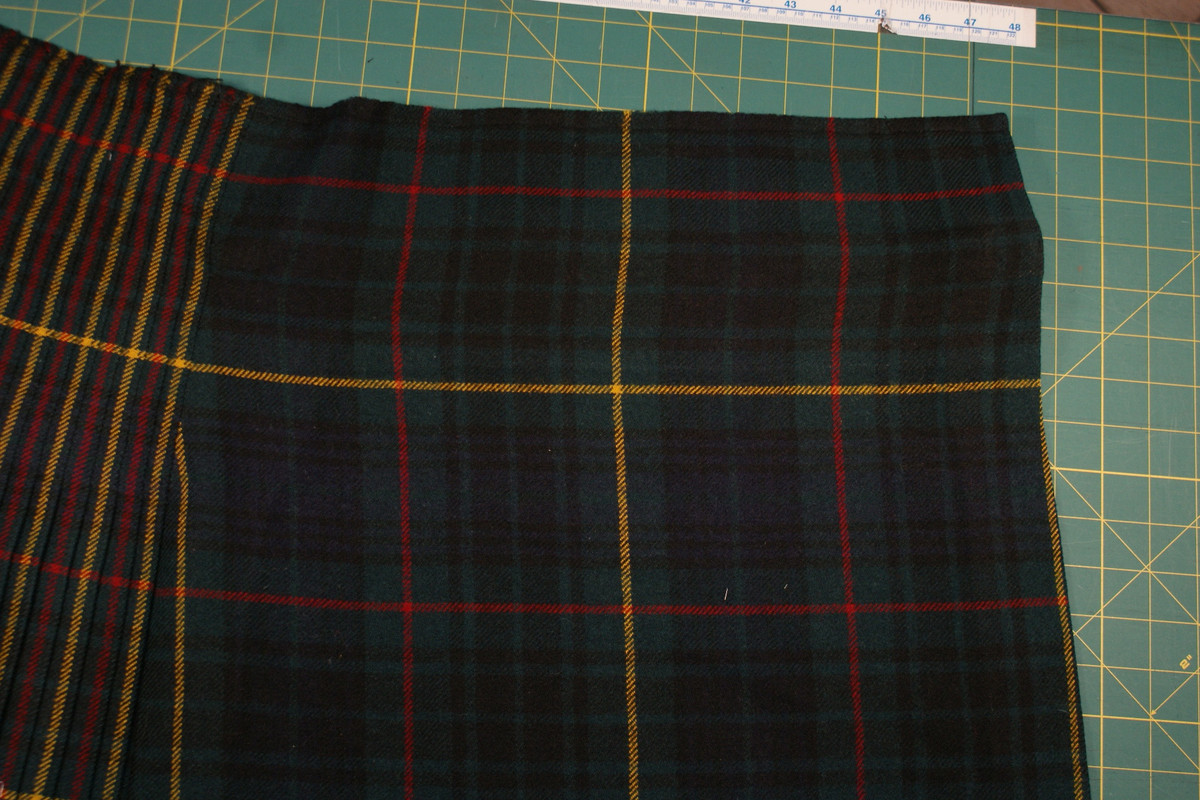
In an extreme case the stitching of the pleats may not be able to resist the stress and may fail, resulting in -

There is nothing wrong with the outer fabric of this kilt. The outer stitching failed when the the inner elements failed. This kilt was reparable but the repair was very expensive.
The issue of the apron edges is one that is very common. Ideally the edges of the aprons should lay gently curved around the legs. Where yours tucks in, is probably caused from when the maker pulled up on the Deep Pleat to anchor the fabric into the waist banding.
The opposite is when the apron edges flip outward or spreads away from the next pleats causing an unsightly gape.
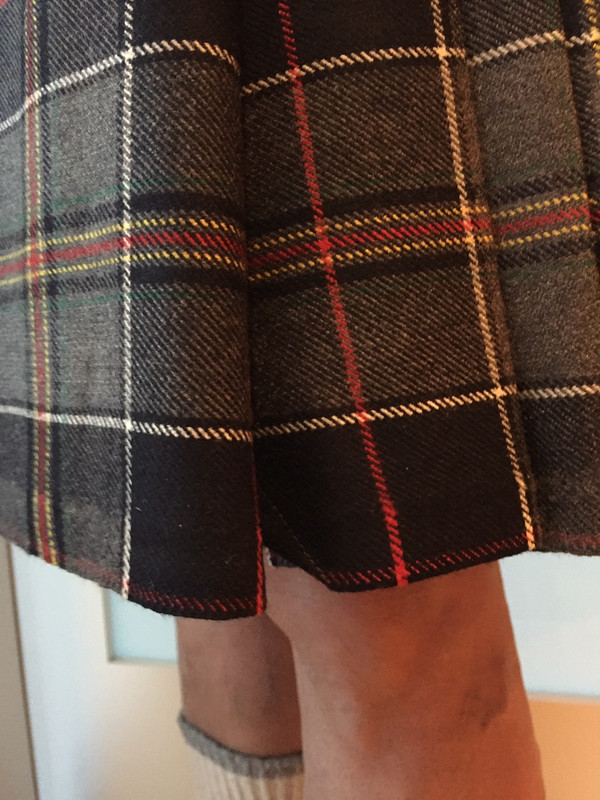
This is usually cause simply by lack of experience. A well made and shaped apron will usually look like this.
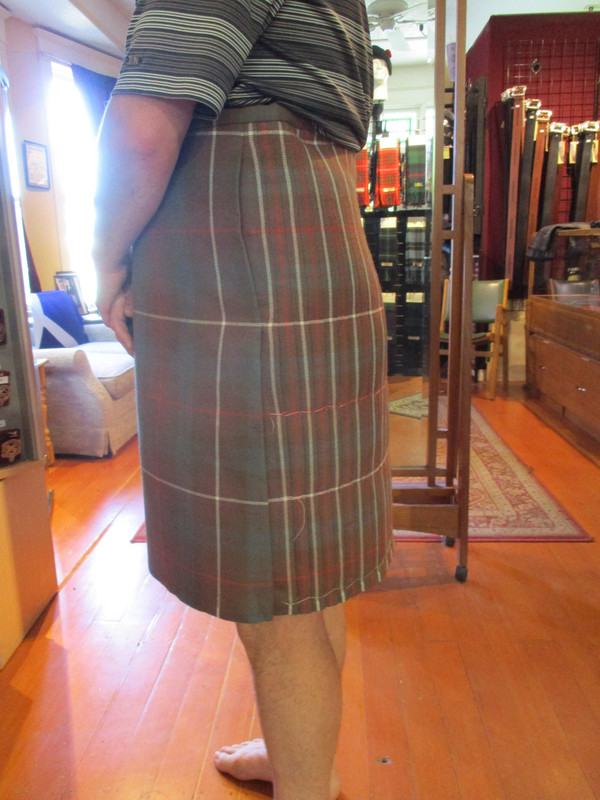
The pucker of the front apron is one of those things that sometimes may be due to how you are wearing the kilt and much less due to how it is made. The aprons will usually lay flat without puckers. BUT - again there is a catch. For the aprons to lay flat, the kilt must be worn in the way that it was designed to be worn. I notice that you are not wearing the kilt with the top, right up under the ribs. Without the top straps cinched into the anatomical waist, the puckers are the result. This is usually not the result of how the kilt was made, but in how it is being worn.
One quick way to know if you are wearing the kilt the way it was designed to be worn, is to put the kilt on and reach around to the back. You should find the bottom of where the stitching starts right at the level of your hips or the crest of the butt. If you find that the bottom of the stitched portion, called The Fell, is below the crest of the buttocks, raising the waist up to the anatomical waist may get rid of the pucker.
Wearing the kilt lower than where it was designed to be worn is the cause of another common problem.
The shower curtains in the rear of the pleats that you see so often today is caused by guys today not knowing that the kilt was designed in a time when all men's trousers were worn much higher than we wear pants today.
This is what a kilt worn lower then it was designed to be worn looks like from the back. (yes, this kilt has other issues but the primary issue is that it is being worn in a manner other than how it was designed to be worn.
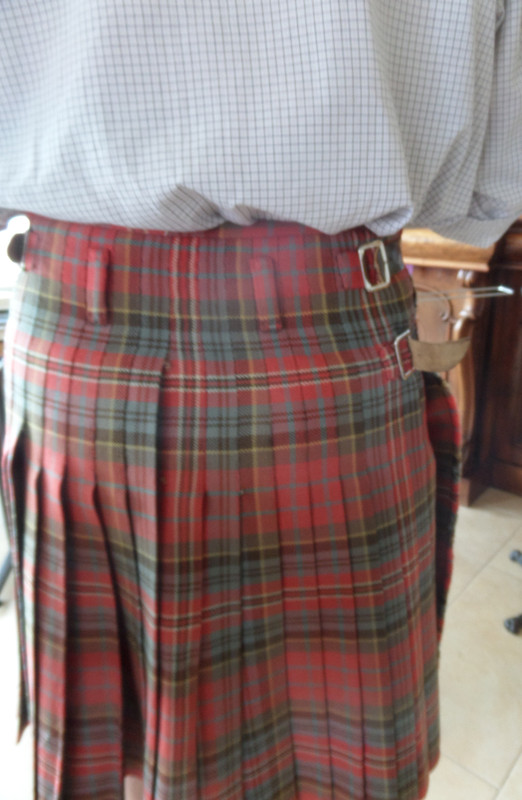
The kilt is one of the only garments today where the wearer must adapt their expectations to the garment and not adapt the garment to the expectations of the wearer.
Finally, under the left side of the outer apron and also under the right side of the under apron there will be what are called the "Deep Pleat" and "Reverse Pleat" respectively. These are there to give enough fabric for the aprons to fall between the legs when you squat or sit. The only requirement is that they are deeper than the rest of the pleats. Sometimes if the maker is a bit short on fabric the deep and reverse pleats may be very small. If the kilt has side slash pockets like mine, they may be quite large.
You should see a small part of the deep pleat folded up and sewn though. This prevents the inner tips from hanging down and being visible when you stand up straight. If the deep and reverse pleats are large the fold up must be large enough to compensate.

I hope this helps you to assess your kilt. Was your kilt made by a master like Barb Tewksbury? No, I'm sorry it is not. But if you are happy with it your kilt, really, that is all that matters.
Last edited by Steve Ashton; 30th July 19 at 05:28 PM.
Steve Ashton
www.freedomkilts.com
Skype (webcam enabled) thewizardofbc
I wear the kilt because: Swish + Swagger = Swoon.
-
The Following 7 Users say 'Aye' to The Wizard of BC For This Useful Post:
 Posting Permissions
Posting Permissions
- You may not post new threads
- You may not post replies
- You may not post attachments
- You may not edit your posts
-
Forum Rules
|
|



































Bookmarks